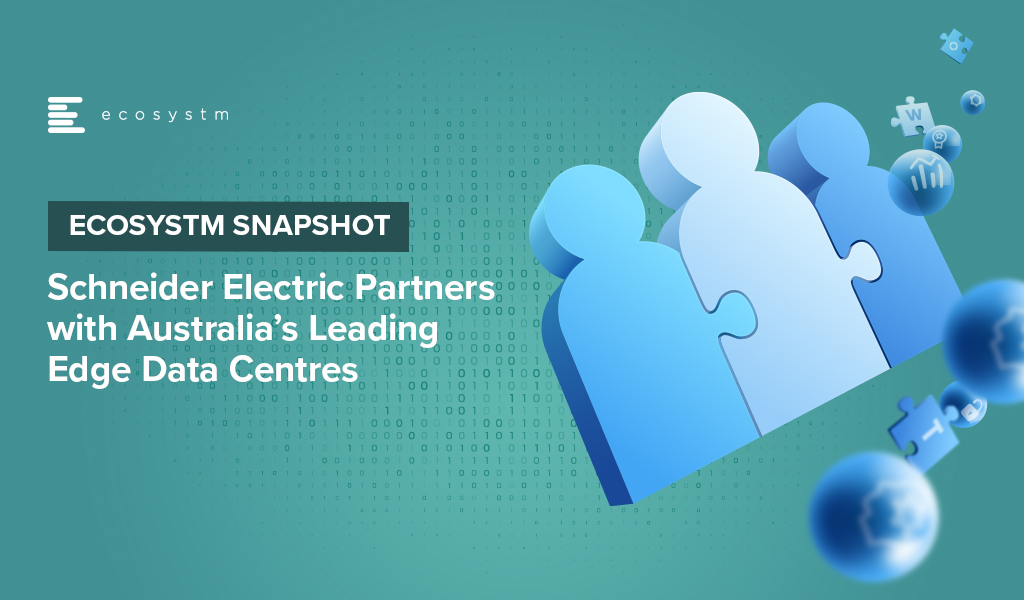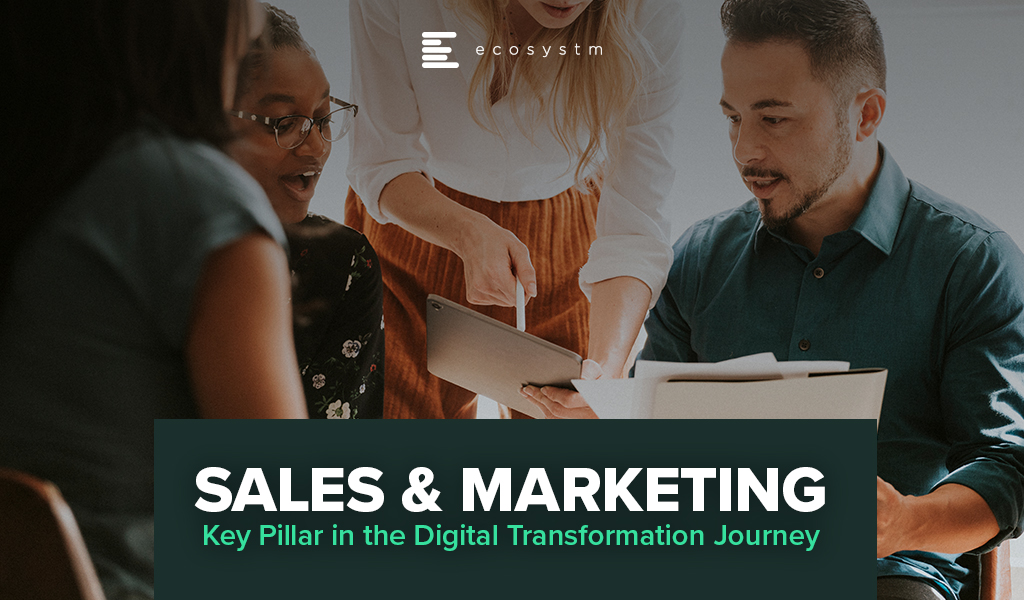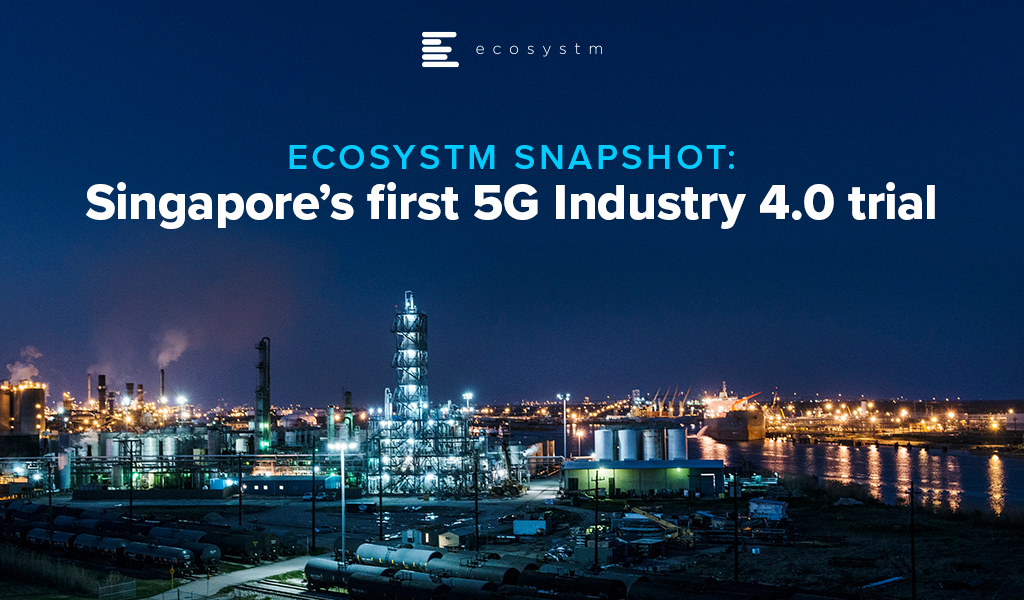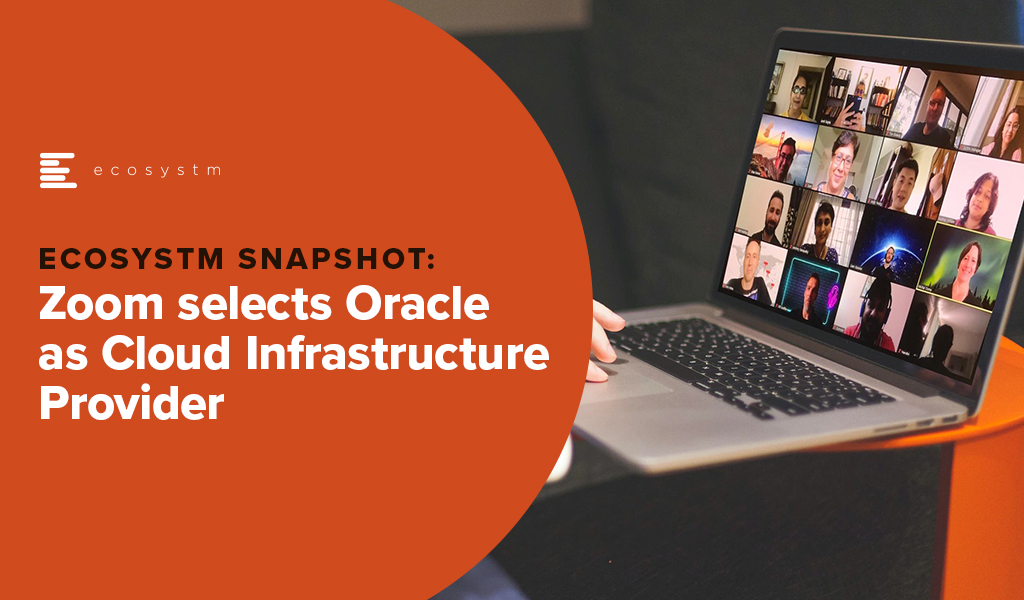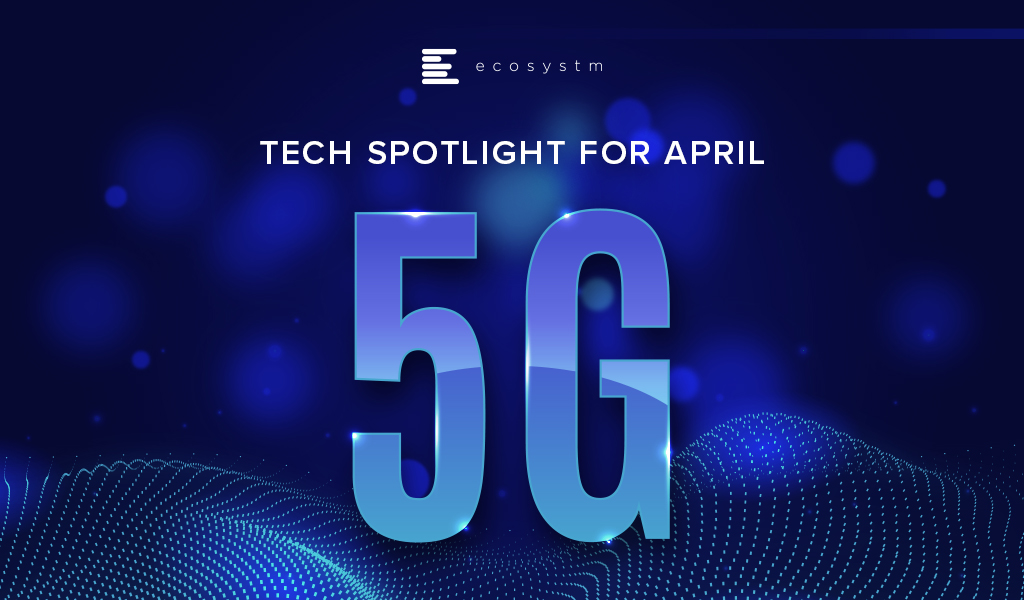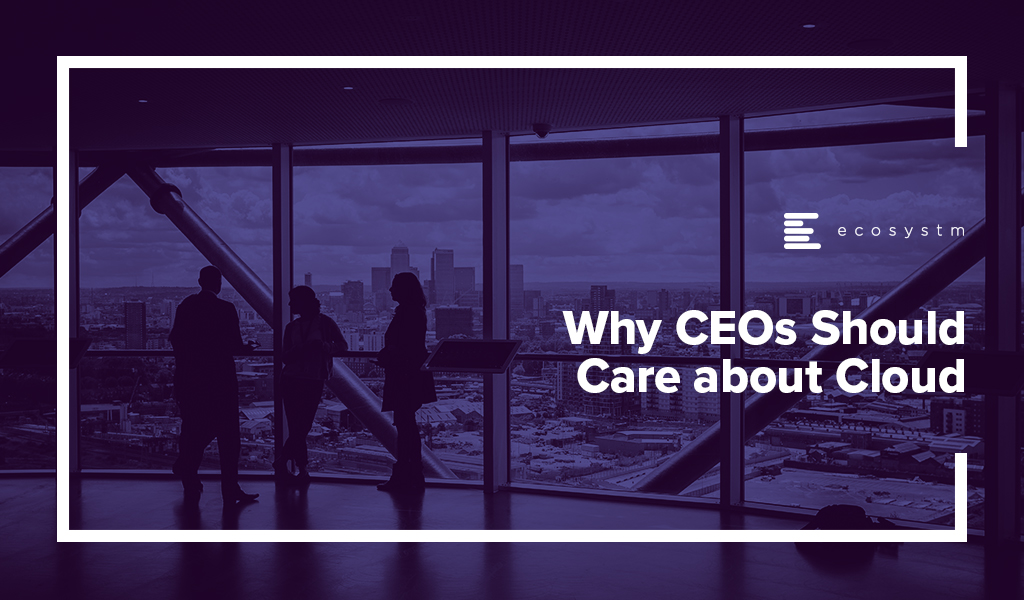Australia’s data centre market has grown exponentially, to a large part due to the Government’s strong policies around cloud adoption. This is in line with the vision of creating a Digital Economy by 2025. Australia’s Tech Future talks about technological changes in 4 key areas including building infrastructure and providing secure access to high-quality data. Availability of local data centres is key to building better infrastructure to support the Digital Economy.
Cloud adoption, especially in the small and medium enterprise (SME) sector is expected to continue to rise. The Ecosystm Business Pulse Study shows that only 16% of Australian organisations had not increased their cloud investments after the COVID-19 crisis and its impact on the economy.
Ecosystm Principal Advisor, Tim Sheedy says, “The current pandemic has highlighted the digital ‘haves and have nots’ in Australia. The NBN has helped to narrow the gap, but too many in rural and regional Australia continue to suffer the tyranny of distance. Businesses and government departments have been reluctant to relocate outside of the major cities due to the lack of internet and data centre infrastructure. Investing in data centres in rural and regional locations will not only help to close the digital divide but also remove a significant barrier that stops businesses from investing in and relocating to locations out of cities.”
Growing Australia’s Data Centre Footprint
This week, Australia’s Leading Edge Data Centres and Schneider Electric announced a AU$30 million project where Schneider Electric will provide Tier-3-designed prefabricated data centre modules for Leading Edge’s six locations in Australia. Each site will host 75 racks with 5kW power density to support computing operations and minimise data exchange delays. Ecosystm Principal Advisor, Darian Bird says, “The inaccessible nature of some sites makes them suitable for prefabricated data centres, which are plug-and-play containers that can be set up and maintained by a relatively small IT team. Standardisation in edge data centres and automation are key to remote management for anyone deploying distributed infrastructure.”
This announcement follows the news that Leading Edge has secured an investment of AU$20 million from Washington H. Soul Pattinson to construct 20 Tier-3 data centres across Australia. They have also received funding from the SparkLabs Cultiv8 2020 accelerator group. The funding will be used to build more than 20 Tier 3 data centres across regional Australia to provide faster internet speeds and direct cloud connectivity.
This will impact businesses that host mission-critical applications, and stricter uptime requirements, and is expected to benefit IoT, AgriTech and telecom industry applications.
Impact on Industry
Edge connectivity will create a seamless experience for the users to take advantage of faster computing with a local host, lower latency by taking connectivity to where operations reside, and data sovereignty by keeping data within the region, aiding in the development of Australia’s Digital Economy.
Sheedy sees this as an opportunity for primary industries. “One of the real challenges for farms and other agribusinesses investing in IoT and other tech-based solutions has been the lack of local or nearby computing infrastructure that will support applications that require low latency. Leading Edge’s investments in providing data centres in rural and regional Australia will mean these businesses can accelerate their digital transformations.”
With the simultaneous rollout of 5G, Smart City initiatives will also benefit from edge data centres. “Investment in edge infrastructure is likely to take off and follow the 5G coverage map across Australia. We will see operators take advantage of their vast network footprint and combine micro data centres with some 5G antenna locations,” says Bird. “Smart City initiatives will be made possible by 5G connected IoT devices but computing at the edge will be needed to keep, for example, public safety systems, operating in real-time. Many monitoring systems will require local data analysis to be effective.”
Bird also sees potential impacts on the Entertainment industry. “The COVID-19 restrictions and the launch of new services such as Disney+ and Binge in Australia will ensure streaming video continues its impressive growth trajectory. Even facilities such as sports stadiums are beginning to deliver in-person digital experiences to grab back attention from their online competitors. Positive user experience is crucial here and low latency is a must. We’ll see a shift towards edge computing delivered on-site as part of a distributed network. Regional data centres and local caching have always been vital for content delivery to ensure the quality of service and reduce bandwidth costs but the scale is unprecedented.”
Bird talks about potential retail opportunities in the future. “We may see anchor tenants at malls offering their excess capacity to smaller, nearby stores that need the benefits of edge but can’t justify the investment, similar to the way Amazon launched AWS.”
Contact centres across industries are being challenged by the current crisis because of the high volume of inbound interactions – through voice and non-voice channels. This has been further compounded by the need to move most of their customer care agents to their homes, especially in countries that have implemented strict social distancing and lockdown measures. This is particularly challenging for the public sector because they are having to respond to an influx of citizen queries regarding COVID-19 specifically (including test centres and availability) and other related areas (information on trade and travel, economic stimulus and so on).
Public Sector Focus on Citizen Experience
Ecosystm research reveals that public sector organisations are hugely focused on citizen experience (Figure 1). But other priorities include employee experience and innovation in their service provision.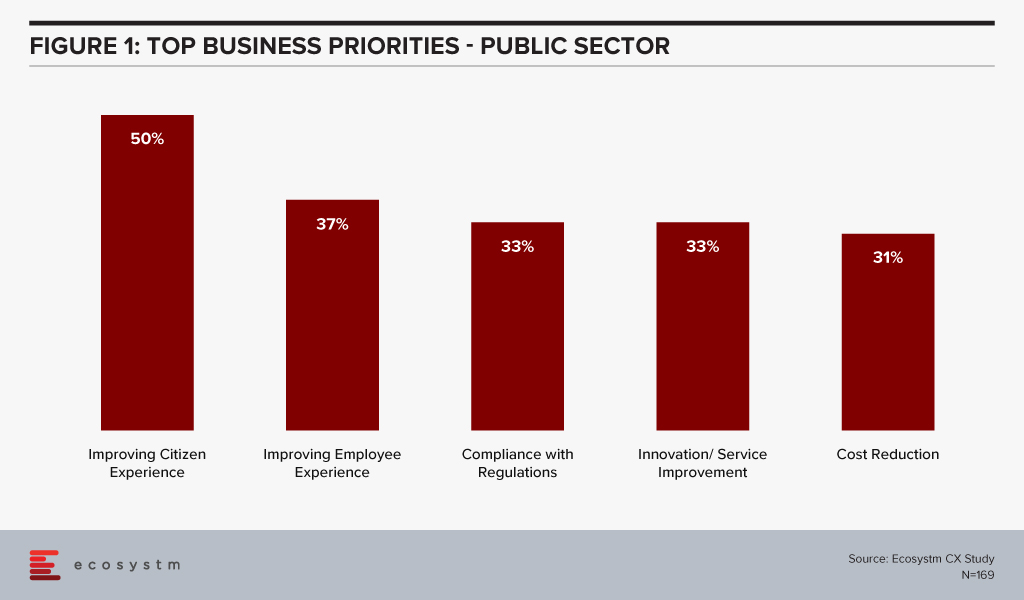
Being able to provide better and innovative service to citizens in a compliant manner is key for every public sector organisation. This has led to governments driving the uptake of cloud solutions, such as the New Zealand Government’s directive to public sector organisations that public cloud services are preferred over traditional IT systems, in order to enhance citizen experiences, streamline operations and create new delivery models. In 2018, the Singapore Government had announced the intention to use commercial cloud services in the public sector. This was fueled as much by the need to overhaul ageing infrastructure, as it was to provide exceptional citizen experience.
Public Sector Adopting Cloud Contact Centres
While the private sector is often quicker in their adoption of digital technologies for better customer experience (CX), the adoption in the public sector can be challenging due to various concerns such as legacy systems, privacy, national security, inter-departmental dependency and more. Ecosystm Principal Advisor, Audrey William says, “Most cloud contact centre solution providers today have the highest level of security wraps and certifications including country-level certifications. However, verticals such as Government, have remained concerned about security. This has not allowed them to innovate as fast as some of the other sectors on leveraging some of the best-in-class customer experience technologies.”
In the US, MAXIMUS, a government services provider company and Genesys recently announced a partnership to set up the MAXIMUS Genesys Engagement Platform, an integrated, cloud-based omnichannel contact centre solution. This was driven by the government requirement for public sector organisations to provide seamless customer experiences similar to those offered in the private sector. The platform is certified by the Federal Risk and Authorization Management Program (FedRAMP). FedRAMP promotes the adoption of secure cloud services across the US Federal Government, in partnership with federal agencies, cloud service providers and 3rd party assessment organisations and provides the standards for security and risk assessment.
This is in line with what we see in the Ecosystm data. Government agencies that use contact centres are increasingly evaluating cloud options, with 17% saying that they operate fully on the cloud (Figure 2). While this may be difficult for all public sector organisations, with mandates around data location and security, a majority are partially on the cloud.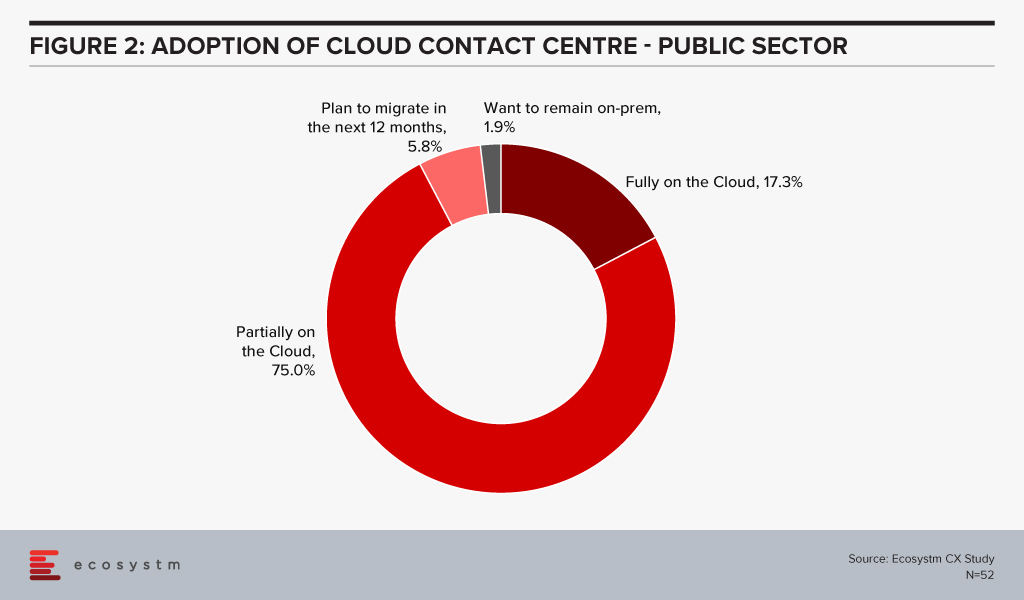
There are several benefits to using the cloud model including the ability to make changes and scale up/down without much customisation or professional services (which can come in handy for a quick re-alignment of the workforce) and manage seasonal spikes. Additionally, cloud solutions allow almost instantaneous access to new features and easy testing of proofs of concept. Public sector organisations are fast realising the value of cloud contact centres.
William sees the FedRAMP certification having immense potential. “FedRamp provides a secured environment for any service that is rolled out as this involves multiple levels of security. Citizens expect a more personalised service through chat, Twitter, mobile, social messaging channels like WhatsApp and many more. However, they also want to feel safe when providing personal information and want to know that the platform that holds their data is secure. When they know that security is at the highest level, they will be more open to providing personal data.”
Managing an Omnichannel Experience
Over half of public sector organisations in the Ecosystm CX study mentioned that they are driving an omnichannel experience for their customers. This has become especially relevant today, as organisations have the need to reduce the call volumes for their contact centres – through non-voice services and customer self-service. The MAXIMUS Genesys Engagement Platform will leverage Genesys Engage, which provides integrated features and functionalities across multiple channels through a single voice and digital user interface. Solutions such as these provide the ability to integrate calls, emails, chats, messages and social comments into one connected platform.
William says, “The cloud platform can help with the highest level of efficiency, scale and speed by integrating multiple channels on a single platform, for more connected customer experience. Government departments will look to leverage capabilities such as Conversational AI, in-app mobile messaging, SMS, email and voice calls within a multi secure environment. Citizens have high expectations from government departments – they expect fast, reliable and efficient service and automation. It would be difficult for governments to provide that level of service without leveraging cloud contact centre technology. That is the only way to move away from inefficient traditional architectures.”
Speaking about the adoption of cloud contact centres in the Asia Pacific region, William says, “Despite initiatives like Australia’s Digital Transformation Agency, the adoption has been relatively low in the public sector. But that has been changing fast with the COVID-19 situation forcing some government departments to move almost immediately to the cloud allowing easier changes to call workflows and other dynamic services that may have to be addressed on a daily basis.”

Organisations across all industries must leverage technology to transform and be part of the digital economy. This has significantly accelerated in the last couple of months as they are forced to transform to survive in these difficult times. Digital Transformation (DX) is no longer a hype, but organisations will continue to struggle to align their transformation priorities to deliver real business impact. From experience, the needs of the Sales & Marketing teams are often lost in the midst of competing for organisational priorities with process optimisation emerging as the first choice.
Why is it necessary for Sales & Marketing to transform?
Organisations’ Business Priorities
The primary reason is that organisations are responding to market pressure and putting customer experience (CX) ahead of even revenue growth as their key business priority (Figure 1).
It stands to reason that if organisations have the improvement of CX and revenue growth as their top priorities, they should involve functions that have higher customer interactions in their DX initiatives. Unfortunately, this is not often the case, even though organisations are inherently aware that their customer base is evolving. Sales & Marketing is all about meeting customer needs, solving their problems and giving them a great experience. In today’s competitive world, an organisation will fail without a customer focus.
The Evolving Consumer
Customers are challenging organisations to change the way they deliver a great experience. Take the growth of smartphone use as an example. Almost any activity will have some element of the smartphone being involved – researching a product, using an app, looking at information posted on a social media platform, engaging with friends to get opinions. This is driving organisations to respond with a ‘Mobile First’ policy and a digital nimbleness which they must equip their Sales & Marketing teams to handle.
Social and digital platforms are also forcing marketers to evolve the way they grab their customers’ attention. Customer service has tremendously benefited from the drive to go digital. It can impact every Sales & Marketing operation, beginning from first consumer touchpoint, all the way through the customer journey, post-purchase engagement and even in predicting issues to prevent them. This requires a huge degree of automation in the Sales & Marketing processes.
Emerging Ecosystems
As the digital world becomes a reality for consumers, the traditional supplier-vendor-channel model might soon become redundant. This is the age of ‘influencers’ – bloggers, customers, vendors, and paid endorsements – and an ever-evolving ecosystem. Engagement with the digital community can be a game-changer for many organisations. Such strong digital community ecosystems are hard to include in the traditional marketing model.
What should Sales & Marketing do to transform successfully?
Ecosystm Principal Advisor, Niloy Mukherjee, has some real-world advice for organisations that are looking to transform their Sales & Marketing practices.
Align with your Basic Strategy
Evaluate your key business goals and work out the changes that are required to achieve those. These changes might be so small and incremental that it may not even appear to be a ‘transformation’. Keeping an eye on the goals, will ensure that you do not invest in areas that do not necessarily need changing. It will also ensure that you simply do not replace an existing process with a new one, without first working out how that change will impact your organisation.
Think beyond features – to the Benefits
Technology investments often end up being the shiny new toy. Decision-makers in organisations may get attracted to snazzy devices and application features – and lose sight of evaluating the true benefits of the technology. For instance, the sales rep selling in-store would have a very good idea of what sells and how much stock to carry. There may be no incremental benefit in equipping the rep with an app that provides real-time sales analytics and inventory data. So, the app gets relegated to being just a feature with no real benefits. On the other hand, a field sales rep might find it extremely useful, especially in sectors that are prone to unpredictable spikes in demand.
Be ready to Invest in the change
You have evaluated the changes that your organisation needs, you have identified the technologies that can truly benefit your organisation – you must be ready to invest in that change. This is not only about financial investments – you have to invest time and in people. This requires your organisation to think of the RoI, again not only in terms of finances but also in terms of effort. Be aware that your biggest challenge in implementing the required change might be people – so invest in making them less resistant and more welcoming of the change.
There will be distractions galore in your transformation journey – emerging tech areas, solutions that seem to be working for your competitors and so on. Mukherjee proposes a simple thumb rule, “If it fits the strategy and looks feasible go with it; if it is outside the agreed strategy then think long and hard, and then turn it down – or change the strategy!”
Click here to download the full report ?

Manufacturing is estimated to account for a fifth of Singapore’s GDP and is one of its growth pillars. Singapore has been talking about re-inventing the Manufacturing industry since 2017, when the Industry 4.0 initiatives to enable digitalisation and process automation of processes and to ensure global competitiveness were first launched. As part of the long-term strategy, the Government had spoken about investment into research and development (R&D) projects, developing transformation roadmaps and strengthening the skill sets of the workforce.
Singapore’s 5G Rollout
Last month, the Infocomm Media Development Authority (IMDA) announced that Singtel and JVCo (formed by Starhub and M1) has won the 5G Call for Proposal. They will be required to provide coverage for at least half of Singapore by end-2022, scaling up to nationwide coverage by end 2025. While Singtel and JVCo will be allocated radio frequency spectrum to deploy nationwide 5G networks, other mobile operators, including MVNOs, can access these network services through a wholesale arrangement. The networks will also be supplemented by localised mmWave deployments that will provide high capacity 5G hotspots.
In October 2019, IMDA and the National Research Foundation had set aside $40 million to support 5G trials in strategic sectors such as maritime, aviation, smart estates, consumer applications, Industry 4.0 and government applications. Ecosystm Principal Advisor, Jannat Maqbool says, “Reach, performance and robustness of connectivity and devices have long held back the ability to scale with the IoT as well as successful deployment of some solutions altogether. The integration of 5G with IoT has the potential to change that immensely. However, and possibly even more importantly, 5G will see the emergence of a true ‘Internet’, defined as ‘interconnected networks using standardised communication protocols’, made up of ‘things’ enabling never-before contemplated innovation – supporting economic development and community well-being.”
“While 5G offers enormous potential to produce economic and social benefits, to reach that potential we need to evaluate from a strategic perspective what it could mean for industries, employers and communities – then we need to invest in the infrastructure, innovation and associated development required to leverage the technology.”
Singapore’s Industry 4.0 Transformation
The Government is also focused on getting the industry ready for the transformation that 5G will bring. Last week, Singapore announced its first Industry 4.0 trial, where IMDA collaborates with IBM, M1 and Samsung to design, develop, test and benchmark 5G-enabled Industry 4.0 solutions that can be applied across various industries. The trials will begin at IBM’s facility in Singapore and involve open source infrastructure solutions from Red Hat to test Industry 4.0 use cases.
The project will test 5G-enabled use cases for Manufacturing, focusing on areas such as automated visual inspection using image recognition and video analytics, equipment monitoring and predictive maintenance, and the use of AR in increasing productivity and quality. The focus is also on leveraging 5G to reduce the cost of processing, by shifting the load from the edge device to centralised systems.
Ecosystm Principal Advisor, Kaushik Ghatak says, “For some time now, the Singapore Manufacturing industry has been in the quest for higher productivity in order to regain its foothold as a destination of choice for global manufacturing outsourcing. The 5G Industry 4.0 trial is a great initiative to fast-track identification and adoption of the right use cases in Manufacturing, in the areas of automation, visibility, analytics, as well as for opening new revenue streams through servitisation of smart products.”
5G will see increased collaboration in the Tech industry
With the advent of 5G, the market will see more collaboration between government agencies, telecom providers and cloud platform providers and network equipment providers. Governments globally have invested in 5G and so have the network and communications equipment providers. However, telecom providers are unsure of how to monetise 5G and cater to the shift in their customer profile from consumers to enterprises. IBM and Samsung had already announced the launch of a joint platform in late 2019. Collaborations such as these will be key to widespread 5G deployment and uptake.
Talking about the benefits of collaborative efforts such as this, Maqbool says, “Robustness and security built into 5G deployment from the outset is essential to enable the applications and innovation that many are promising the technology will deliver, including the ability to self-scale, automate fault management and support edge processing.”
It is interesting that the solutions developed will be featured at IBM’s Industry 4.0 Studio 5G Solutions Showcase, and that IBM and Samsung will evaluate successful solutions developed during the project for possible use in their operations in a broad range of markets and sectors. “Availability of proven use cases at IBM’s Solutions Showcase centre would benefit local manufactures greatly; in terms of easy access to right skills and proven technology architectures,” says Ghatak. “This initiative is a huge step towards realising the promise of the cyber physical world. The collaboration between the leaders in communications, equipment and software will ensure that the use case development is truly cutting edge.”

The COVID-19 crisis has forced countries to implement work from home policies and lockdowns. Since the crisis hit, uptake of cloud communication and collaboration solutions have seen a dramatic increase. Video conferencing provider, Zoom has emerged as a key player in the market, with a rapid increase in user base from 10 million daily active participants in December 2019 to 200 million in March 2020 – a growth in the number of users of nearly 200%!
Security Concerns around Zoom
The rapid increase in user base and the surge in traffic has required Zoom to re-evaluate its offerings and capacity. The platform was primarily built for enterprises and now is seeing unprecedented usage in conducting team meetings, webinars, virtual conferences, e-learning, and social events.
The one area where they were impacted most is security. In his report, Cybersecurity Considerations in the COVID-19 Era, Ecosystm Principal Advisor Andrew Milroy says, “The extraordinary growth of Zoom has made it a target for attackers. It has had to work remarkably hard to plug the security gaps, identified by numerous breaches. Many security vulnerabilities have been discovered with Zoom such as, a vulnerability to UNC path injection in the client chat feature, which allows hackers to steal Windows credentials, keeping decryption keys in the cloud which can potentially be accessed by hackers and the ability for trolls to ‘Zoombomb’ open and unprotected meetings.”
“Zoom largely responded to these disclosures quickly and transparently, and it has already patched many of the weaknesses highlighted by the security community. But it continues to receive rigorous stress testing by hackers, exposing more vulnerabilities.”
However, Milroy does not think that this issue is unique to Zoom. “Collaboration platforms tend to tread a fine line between performance and security. Too much security can cause performance and usability to be impacted negatively. Too little security, as we have seen, allows hackers to find vulnerabilities. If data privacy is critical for a meeting, then perhaps collaboration platforms should not be used, or organisations should not share critical information on them.”
Zoom to increase Capacity and Scalability
Zoom is aware that it has to increase its service capacity and scalability of its offerings, if it has to successfully leverage its current market presence, beyond the COVID-19 crisis. Last week Zoom announced that that it had selected Oracle as its cloud Infrastructure provider. One of the reasons cited for the choice is Oracle’s “industry-leading security”. It has been reported that Zoom is transferring more than 7 PB of data through Oracle Cloud Infrastructure servers daily.
In addition to growing their data centres, Zoom has been using AWS and Microsoft Azure as its hosting providers. Milroy says, “It makes sense for Zoom to use another supplier rather than putting ‘all its eggs in one or two baskets’. Zoom has not shared the commercial details, but it is likely that Oracle has offered more predictable pricing. Also, the security offered by the Oracle Cloud Infrastructure deal is likely to have impacted the choice and it is likely that Oracle has also priced its security features very competitively.”
“It must also be borne in mind that Google, Microsoft and Amazon are all competing directly with Zoom. They all offer video collaboration platforms and like Zoom, are seeing huge growth in demand. Zoom may not wish to contribute to the growth of its competitors any more than it needs to.”
Milroy sees another benefit to using Oracle. “Oracle is known to have a presence in the government sector – especially in the US. Working with Oracle might make it easier for Zoom to win large government contracts, to consolidate its market presence.”
Gain access to more insights from the Ecosystm Cloud Study

April saw the disruption of normal business operations due to the COVID-19 crisis. However, telecommunications companies continued initiatives to identify the best ways to serve customers and enterprises. The month saw a lot of activity in the 5G space across the globe, including partnerships, innovation in productisation and identifying 5G use cases.
Telecom providers building their 5G capabilities
Ecosystm Principal Advisor, Shamir Amanullah noted in his blog that in the new normal telecom providers have fast evolved as the backbone of business and social interactions. Telecom operators are fervently working towards 5G network and services deployment in order to be an early mover in the market. In China, China Mobile has been one of the leaders in rolling out country-wide 5G. The tender to build around 250,000 fifth-generation wireless network base stations across 28 provincial regions was put out in March and in early April, Huawei emerged as the key winner with the contract to build nearly 60% of the base stations. ZTE also won nearly a third of the contract. Global network equipment providers will find entering the China market as challenge for a number of reasons, including the strength of their local players.
Huawei continues to be under scrutiny in the global market, however British telecom provider chose Ericsson to build the core of its 5G network. BT hopes to create and define a future roadmap of new services such as mobile edge computing, network slicing, enhanced mobile broadband and various enterprise services. The US market is another arena where the battle for 5G will be fought out. The T-Mobile – Sprint merger was finalised in early April. The New T-Mobile is committed to building the world’s best nationwide 5G network, which will bring lightning-fast speeds to urban areas and underserved rural communities alike. Other vendors are also vying for a larger share of the US market. Nex-Tech Wireless, a smaller rural telecom provider based in Kansas, is planning to transition from 4G to 5G by using Ericsson’s Dynamic Spectrum Sharing (DSS) to deploy 5G on existing bands. This will help Next-Tech wireless to leverage existing assets instead of building 5G capabilities from the ground-up – enabling them to seamlessly transfer from 4G to 5G.
The 5G developments are by no means limited mostly to the US and China. Korea’s telecom provider, KT and Far EasTone Taiwan (FET) signed an MOU to collaborate and jointly develop 5G services and digital content. With this deal, KT plans to boost its 5G powered content and services presence through FET.
Tech Vendors evolving their 5G offerings
Network and communications equipment providers have much to gain and more to lose as organisations look to leverage 5G for their IoT use cases. If 5G uptake does not take off, the bigger losers will be the network and communications equipment providers – the real investors in the technology. Also, as telecom providers look to monetise 5G they will find themselves dealing with a completely different customer base – they will take help from tech vendors that have more experience in the enterprise space, as well as industry expertise. Both network equipment vendors and other tech vendors are actively evolving their product offerings. There were numerous examples of this in April.
Microsoft’s decision to acquire Affirmed Networks is an example of how the major cloud providers are trying to be better embedded with 5G capabilities. This month also saw Microsoft announce Azure Edge Zones aimed at reducing latency for both public and private networks. AT&T is a good example of how public carriers will use the Azure Edge Zones. As part of the ongoing partnership with Microsoft, AT&T has already launched a Dallas Edge Zone, with another one planned for Los Angeles, later in the year. Microsoft also intends to offer the Azure Edge Zones, independent of carriers in denser areas. They also launched Azure Private Edge Zones for private enterprise networks suitable for delivering ultra-low latency performance for IoT devices.
The examples go beyond the cloud platform providers. Samsung and Xilinx, have joined forces to enable 5G deployments, with Samsung aiming to use the Xilinx Versal adaptive compute acceleration platform (ACAP) for worldwide 5G commercial deployments. Versal ACAP offers the compute density at low power consumption to perform the real-time, low-latency signal processing needed by 5G. Following the successful pilot of 450 MHz proof of concept 5G network, Nokia has partnered with PGE Systemy, a large energy sector company in Poland to deploy industrial grade 5G solutions and to support energy distribution for its next gen power grid. It is the band of choice for machine-to-machine communications in the energy sector, including smart meters. Nokia also released an AI-as-a-service offering – Nokia AVA 5G cognitive operations – to help telecom providers transform their services with AI-based solutions to support, network, business and operations.
Use cases for 5G adoption firming up
5G promises to revolutionise various industry solutions based on required data rates, low latency, reliability, and machine-type communications. Telecom providers and tech vendors alike are working on developing industry use cases to drive up adoption.
Vodafone Qatar and Dreama Orphan Care Centre and Protection Social Rehabilitation Centre (AMAN) have collaborated to support remote learning and education using 5G technology. This is aimed to enhance virtual education through e-learning, online schools, and connecting teachers and students through high-speed learning environment. In the post-COVID 19 era remote learning is expected to become a key sector and there is immense potential for uptake.
The Manufacturing industry remains a top focus area for 5G providers, with their early adoption of sensors and sensor data analytics. The Smart Internet Lab at the University of Bristol, UK has been awarded a 2 years project by UK’s Department for Digital, Culture, Media and Sport (DCMS) to enable 5G connectivity for the manufacturing sector. The project will primarily work on improving productivity and manufacturing, easy asset tracking and management with involvement of AR/VR technologies and industrial system management.
Gaming is another sector with huge potential for 5G adoption. With cloud gaming, gamers can access a library of popular high-quality games minus the need for expensive hardware which has been the case in the past. China Mobile Hong Kong and Ubitus teamed up to launch a 5G cloud gaming service – UGAME. The application is available for download from the Google Play store. While still at a beta phase, the telecom provider promises a revolutionary gaming experience, where the need for computers or consoles will be lessened by augmented smartphone capabilities.
In the midst of the uncertainties, telecom, network equipment providers and cloud platform providers appear to be gearing up for 5G in enabling a contactless and remote economy.
India has clearly been a target market for Facebook due to the size of the country’s untapped market and the proportion of its younger population. It is estimated that nearly 45% of the population is below 25 years – a prime target for social media and eCommerce platforms. Facebook’s Free Basic program, launched in 2016 to introduce the potential of the Internet to the underprivileged and digitally unskilled, failed primarily because it did not have knowledge of the telecommunications market in India. Facebook returned to the India market the following year, this time in collaboration with Airtel, to launch Express WiFi, aimed at setting up WiFi hotspots to provide internet in public places – again aimed at India’s connectivity issues.
Making its largest foray into the Indian market yet, last week Facebook announced that it is investing US$5.7 billion in Jio Platforms – India’s largest telecom operator – for a 9.9% minority stake. Facebook makes its intentions very clear and is targeting the 60 million small and medium enterprises (SMEs) who can be the backbone of India’s growing digital economy. This includes a rather unorganised retail sector, which has had to adopt digital at breakneck speed following the Government’s earlier financial reforms, which impacted the smaller retailers, dependent primarily on cash transactions. Facebook is by no means the only global giant with an interest in India’s retail business – with Amazon and Walmart leading the way.
The JioMart and WhatsApp Pilot
Just days after the announcement, JioMart – an eCommerce venture also a wholly-owned subsidiary of Reliance Industries, like Jio Platforms – has launched a pilot in Mumbai which allows users to order groceries through WhatsApp. Customers can now place grocery orders through WhatsApp Business with JioMart reaching out to small-scale retailers and brick and mortar stores – or “Kirana stores” as they are referred to in India – to fulfil the order. More than 1,200 local stores have been engaged for this pilot. It currently does not include a digital payment option and invoices and alerts are sent through WhatsApp. Mukesh Ambani, Chairman and MD of Reliance Industries, says that the JioMart and WhatsApp collaboration has the potential to make it possible for around 30 million neighbourhood stores to transact digitally.
India Emerging as the New Battlefield
India is an important eCommerce market for global giants such as Facebook and Amazon, who have struggled with establishing a presence in China. Walmart has also set it its sights on India, with its recent acquisition of Flipkart. Ecosystm Principal Advisor, Kaushik Ghatak says. “India represents the final frontier, where the battle lines are being drawn, and the three are heading towards a collision path. Facebook’s recent move has just upped the game for Amazon and Walmart, as well as for the eCommerce and Fintech start-ups who have been eyeing this market.”
Amazon has been the early mover, establishing its eCommerce presence in India way back in 2013. Ghatak says, “From its initial marketplace approach of curating suppliers to start selling on its platform, Amazon graduated to offering its own delivery and fulfilment services, by establishing dozens of warehouses across India. This was to ensure the quality and timeliness of deliveries, upholding its ‘Fulfilment by Amazon’ (FBA) brand promise. There was a considerable cost though, in terms of time to ramp up and investments – with the associated asset risks. Also, reaching out to the diffused retail sector, with their non-existent or very low level of digitalisation, has been difficult for all the major eCommerce players such as Amazon and Flipkart. Jeff Bezos’ announcement of an additional investment of $ 1 billion, earlier this year, to digitise SMEs, allowing them to sell and operate online, is a step to extend its reach into this diffused retail market.”
JioMart’s model, according to Ghatak is in stark contrast to Amazon’s. “JioMart’s currently ongoing pilot in Mumbai is a classic B2C marketplace model, with little or no asset risk. The orders placed by the customers are routed to the nearest Kirana store based on stock availability, with the customers going to pick up the ordered items themselves at times.”
Ecosystm Principal Advisor, Niloy Mukherjee says, “Jio has unparalleled market access in India with reports showing north of 370 million subscribers. Even at a $1.7 per month revenue from such a huge number, one can get to a $7.5 billion-dollar annual business. But even this is dwarfed by what that subscriber base itself is worth – through the data it provides, the products that can be sold and so on. Similarly, WhatsApp will prove to be more important than Facebook in India, with more than 400 million users. Using WhatsApp to get Kirana stores to do delivery can be a true game-changer.”
Talking about how this competes with Amazon, Mukherjee says, “This can eat into the business of an Amazon and my guess is, it will be far more efficient. The proximity to the customer will allow multiple deliveries per day at short notice, and fresh produce guarantees – maybe even door returns if not satisfied – that would be hard to match. Given the traffic situation in large Indian cities, delivery logistics from a more distant source will always struggle to compete. This is one tip of a multi-pronged spear – there are obviously other products that can be contemplated, leading to additional revenues.”
The Possibilities Ahead
Mukherjee explains why he thinks Facebook invested in Jio Platforms, rather than just forging a collaboration model. “Clearly both parties want to tie the other down and make sure that this alliance is long term. And this possibly means revenue will be shared instead of the usual commission model. Also, the go-to-market implications can run to more than just the Indian market. WeChat Pay is huge in China but not really elsewhere. If this works, there could be a potential “WhatsApp Pay” in the rest of the world. For Jio who already dominates the telecom landscape in India, this deal is a step towards taking their earnings to a new level, above the top end of the telecom category – they can access profit pools available to hardly any telecom provider worldwide.”
At a time when a market entry for foreign players in India is getting tougher with increasing regulatory pressures, a tie-up with the biggest player in India is indeed a very promising step – for both Facebook and Reliance. “For Facebook, this is a great opportunity to take its dependence away from a primarily ad-driven revenue model. The digitalisation of the diffused retail sector in India will open up new revenue opportunities from its WhatsApp Business App, WhatsApp Business API, and WhatsApp Pay-UPI gateway (pending regulatory approval). There is a potential of revenues from a variety of marketing services, membership fees, customer management services, product sales, commissions on transactions, and software service fees,” says Ghatak.
Talking about the potential for Reliance Industries, Ghatak says, “The technology horsepower of Facebook will help propel them ahead of Fintech and eCommerce companies in India – challenging already established players such as Amazon and Flipkart, and the newbie start-ups. Ability to drive transactions and digital payments in the diffused retail sector will open up huge revenue opportunities that were largely untapped until now, with low asset risks. Also, this sector has traditionally operated on a cash-based model and the recent COVID-19 crisis has exposed how vulnerable the sector is with a limited view of the supply chain, and limited funding for working capital. Developing relationships with the millions of Kirana stores spread across India also gives the opportunity of revenue generation through supply chain financing – a largely ignored sub-sector until now.”
Mukherjee thinks that this alliance will challenge players such as Amazon and Amazon Pay, Google Pay and PayTM. Ghatak also thinks that eventually, Jio Platform will have to either choose between or integrate the best features of WhatsApp Pay and the Jio Money Merchant payment gateways.
However, Ghatak offers a word of caution on the downside risks as well. “Partnering with Facebook is a hugely ambitious game plan for Reliance Industries. The success of its plans will also depend on how well it is able to curate the suppliers who are responsible for the actual delivery. In a consumer-driven business model, trust and customer experience cannot be compromised. The low asset, high leverage and high reach model can unravel itself if the customer gets the short end of the stick, in this rush for eCommerce domination.”
CEOs have an active role to play in an organisation’s transformation needs and journey – including in the technology decisions. Last month we spoke about why CEOs should get involved in their organisation’s IoT investments. Now, we look at Cloud – which has been a part of the CIO’s purview so far. Under the current circumstances, most organisations are actively pushing to go digital and the internal discussions will often revolve around empowering remote employees and digital customers. All the technologies that are being evaluated by organisations today have Cloud as their pillar. Increasingly, we see organisations adopt the hybrid and the multi-cloud. And organisations may not have the capabilities – technological and skills – to support the complexity of their Cloud environment. While a CEO does not have to understand the technology fully, it is important to understand the business impact of the technology.
Why should a CEO get involved in and have visibility into an organisation’s Cloud investments? There are a few important reasons.
#1 Cloud is not a cost-saving measure – it will enable you to transform
Organisations have matured in their Cloud adoption and no longer evaluate the benefits of Cloud only in terms of shifting CapEx to OpEx. If we look at the benefits of Cloud adoption, reduction of IT costs is not even in the top 3 benefits that organisations are seeking from Cloud anymore. Operational efficiency and collaboration emerge as key benefits (Figure 1) – while some companies still move to the Cloud for the savings, they stay there for other benefits.
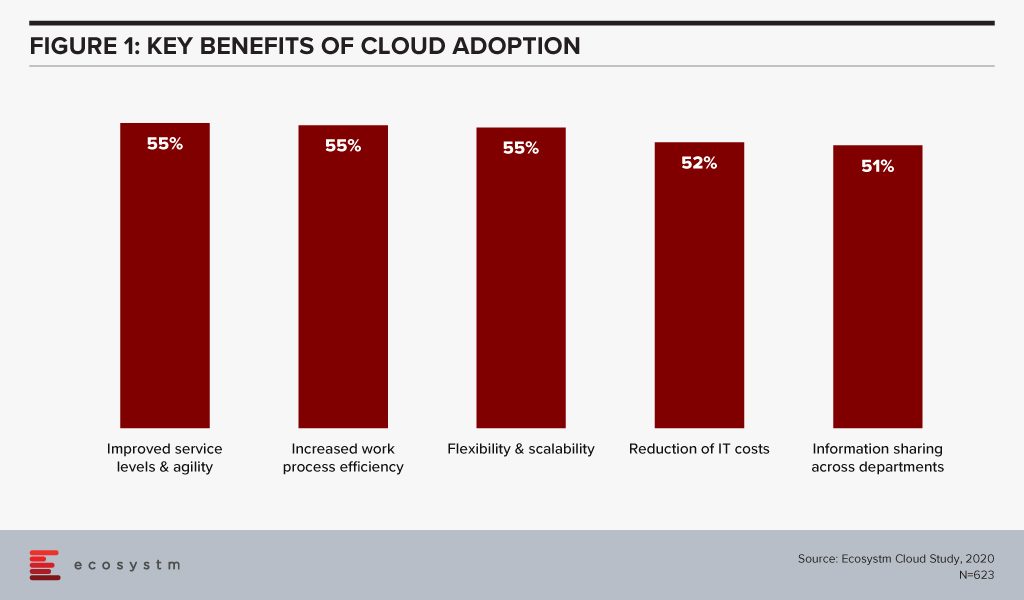
This requires organisations to think of Cloud as a technology empowering their infrastructure and services. Cloud acts as an enabler for ease of doing business, real-time data access for productivity increase, and process automation. This impacts the entire organisation. It also involves prioritising the needs of certain functions over others – definitely not what a CIO should have to do.
If we look at just Cloud storage as an example, organisations can no longer have individual functions and their associated shadow IT teams having their own Cloud storage (and collaboration). This often turns out to be more expensive and there is a lack of consolidated view and management. While organisations forge ahead with the dream of having real-time information sharing across functions, a CIO has to consider the entire organisation’s technological and business needs – a CEO is the best person to guide the CIO in translating the organisation’s vision into IT priorities.
#2 In fact Cloud adoption may not cut costs at all!
Organisations are also re-evaluating the cost benefits of Cloud. Investing in a Cloud infrastructure with a short-term view on the investments involved has led to instances of Cloud solutions being brought back in-house because of rising costs. While security, data privacy and integration remain the key challenges of Cloud adoption (Figure 2), over a third of the organisations find Cloud more expensive than traditional licensing or owning the hardware.
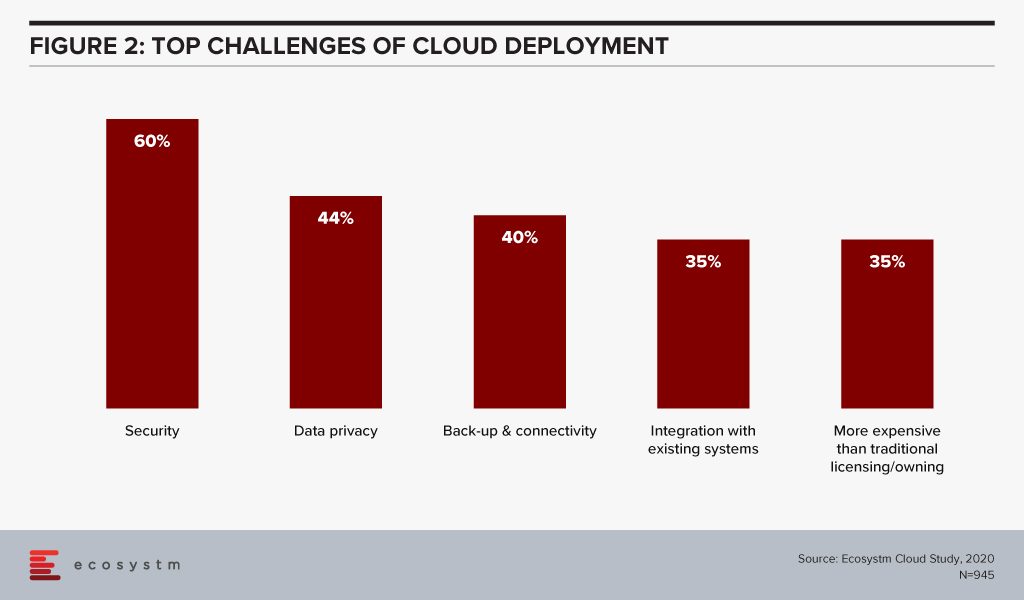
Organisations find that the cost considerations do not stop after the adoption or migration. As businesses use Cloud to scale, there are several aspects that require constant re-evaluation and often further investments – cybersecurity measures, continuous data protection (CDP), disaster recovery management, rightsizing capacity, software and database licenses and day-to-day maintenance, to name a few. In addition to this, the cost of finding and recruiting a team of professionals to manage and maintain the Cloud environment also adds up to the OpEx.
If the CIO is talking about a Cloud migration for cost benefits only, the CEO and the CFO need to step in to evaluate that all factors have been taken into consideration. Moreover, the CIO may not have full visibility of how and where the organisation is looking to scale up or down. It is the CEO’s responsibility to share that vision with the CIO to guide Cloud investments.
#3 Cloud will increasingly be part of all tech adoption considerations
In this disruptive world, CEOs should explore possibilities and understand the technical capabilities which can give organisations an edge over their competitors. It is then up to the CIOs to implement that vision with this larger context in mind. As organisations look to leverage emerging technologies, organisations will adopt Cloud to optimise their resources and workloads.
AI is changing the way organisations need to store, process and analyse the data to derive useful insights and decision-making practices. This is pushing the adoption of Cloud, even in the most conservative organisations. Cloud is no longer only required for infrastructure and back-up – but actually improving business processes, by enabling real-time data and systems access. Similarly, IoT devices will grow exponentially. Today, data is already going into the Cloud and data centres on a real-time basis from sensors and automated devices. However, as these devices become bi-directional, decisions will need to be made in real-time as well. Edge Computing will be essential in this intelligent and automated world. Cloud platform vendors are building on their edge solutions and tech buyers are increasingly getting interested in the Edge allowing better decision-making through machine learning and AI.
In view of the recent global crisis, we will see a sharp uptake of Cloud solutions across tech areas. IaaS will remain the key area of focus in the near future, especially Desktop-as-as-Service. Organisations will also look to evaluate more SaaS solutions, in order to empower a mobile and remote workforce. This will allow the workforce of the future to stay connected, informed and make more decisions. More than ever, CEOs have to drive business growth with innovative products and services – not understanding the capabilities and challenges of Cloud adoption and the advancements in the technology can be a serious handicap for CEOs.
#4 Your IT Team may be more complacent about Cloud security than you think
Another domain that requires the CEO’s attention is cybersecurity. The Cloud is used for computing operations and to store data including, intellectual property rights, financial information, employee details and other sensitive data. Cybersecurity breaches have immense financial and reputational implications and IT Teams cannot solely be responsible for it. Cybersecurity has become a Board-level conversation and many organisations are employing a Chief Information Security Officer (CISO) who reports directly into the CEO. Cybersecurity is an aspect of an organisation’s risk management program.
Evaluating the security features of the Cloud offerings, therefore, becomes an important aspect of an IT decision-maker’s job. While security remains a key concern when it comes to Cloud adoption, Cloud is often regarded as a more secure option than on-premise. Cloud providers have dedicated security focus, constantly upgrade their security capabilities in response to newer threats and evolve their partner ecosystem. There is also better traceability with the Cloud as every virtual activity can be tracked, monitored, and logged. Ecosystm research finds that more than 40% of IT decision-makers think the Public Cloud has enough security measures and does not need complementing (Figure 3).
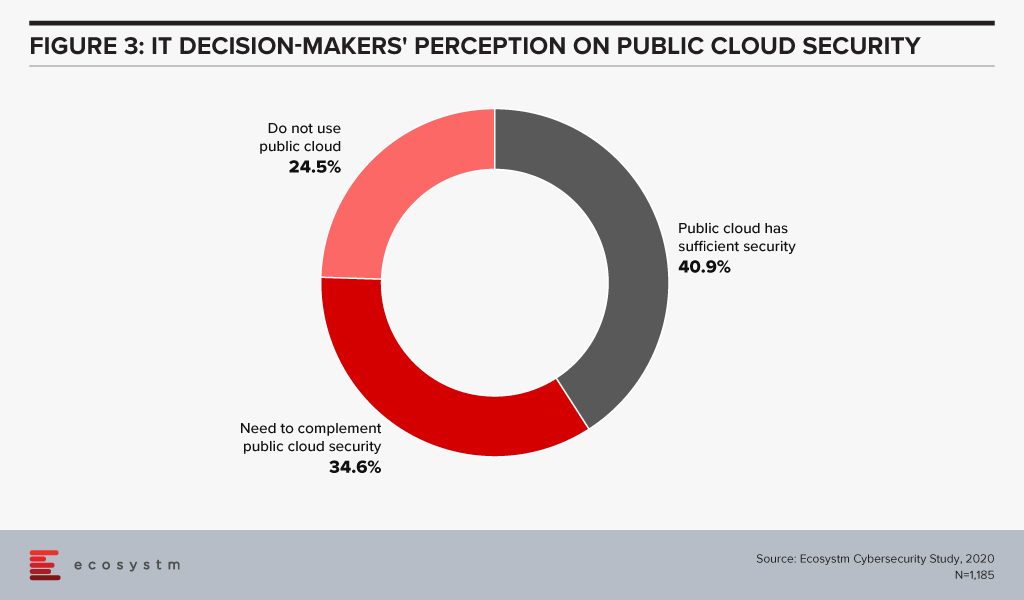
However, the Cloud is as secure as an organisation makes it. The perception that there is no need to supplement Public Cloud security features can have disastrous outcomes. It is important to supplement the Cloud provider’s security with event-driven security measures within an organisation’s applications and cloud interface.
It is the job of the CEO – through the CISO – to evaluate how cyber ready the IT Team really is. Do they know enough about shared responsibility? Do they have full cognizance of the SLAs of their Cloud providers? Do they have sufficient internal cybersecurity skills? Do they understand that data breaches can have cost and reputational impacts? As cybersecurity breaches begin to have more financial implications than ever and can derail an organisation, a CEO should have visibility of the risks of the organisation’s Cloud adoption.
Cloud is no longer just a technological decision – it is a business decision and takes into account the organisation’s vision. A full visibility of the Cloud roadmap – including the pitfalls, the risks and the immense potential – will empower a CEO immensely.

The ongoing global crisis is expected to drive more investments in Fintech, especially in the area of digital payments, as more organisations and consumers adopt eCommerce. Fintech will also continue to grow in areas such as Regtech and Blockchain for ease of reporting and enhanced transaction security.
Ecosystm Principal Advisor, Paul Gestro says, “In the environment, we find ourselves in now – and will be for some time – we have likely already switched to a number of new online channels, or at the very least increased the use of them. Fintech has played a big role already with online shopping & delivery, contactless payments and the general reduction in face to face transacting. Small and medium enterprises (SMEs) may gain the most as Fintech has enabled credit to be approved and distributed faster, either by banks or governments.”
“Fintech have been able to develop bespoke applications based on their open platforms to provide immediate channels to get much-needed capital flowing through the economy. Governments have often turned to the Fintechs first rather than traditional financial institutions. If Fintechs can still access investment capital to survive and keep growing, they will continue to disrupt the intermediaries across all sectors. It is yet to be seen if this will accelerate or be curtailed, but that will depend on how the financial institutions react to whatever the new normal will be.”
The Role of Blockchain in Financial Services
Talking about the role of Blockchain in Financial Services, Gestro says, “Overall Blockchain will lead to a more open and interconnected economy that is borderless, transparent and does not need counter-party trust to operate. To date, banks and other financial institutions have been the intermediary to make this happen but, in many areas, it can be slow and costly. Blockchain has the advantage of eliminating the intermediary or ‘middleman’.”
“One particular area is the use of ‘Smart Contracts’. Financial contracts involve legal work, document handling, sighting, signing and sending them to the right people. All of this involves both time and people and proves to be an expensive option eventually. Blockchain can speed this process up in a secure (with no failure points), interoperable and risk-free environment. Trade finance, lending and Islamic Banking are all potential areas that will benefit immensely.”
However, Gestro also extends a word of caution. “On paper, a cross-border Blockchain ecosystem makes perfect sense. However financial institutions have strict and long-standing governance and compliance boundaries that do not make it so easy to ‘switch’ to Blockchain overnight. The entire rationale of Blockchain is decentralising the legacy of competing rules and regulations and different agendas – this would mean that without a decision-maker, bottlenecks will form,” says Gestro. “On the other hand, financial institutions have also developed rapid transactional processing capability and Blockchain technology may be a long way from replicating that speed. So, even though Blockchain will prove immensely beneficial, scalability, risk management and compliance are the three areas that are inhibiting financial institutions from a full-blown adoption.”
Blockchain in Islamic Banking
One of the key benefits of Fintech is to drive financial inclusion. This is particularly true when it comes to widespread access to Islamic Banking facilities. With Fintech, Islamic Banking becomes more accessible to a larger population who do not bank because the banking and financial practices are not Shariah-compliant. Gestro sees a clear role of Blockchain in Islamic Banking. “The two key principles of Islamic Banking are the sharing of profit/loss and the prohibition of interest collection/payment. A key principle of Blockchain finance is smart contracts. With smart contracts, the entire contractual process can be automated quickly and transparently with the terms of each contract enforced as it should. A smart contract will be in compliance with the Shariah objective of ensuring transparency in a deal with clear asset definitions, payment terms and enforcement – all aligned with the principles of trust.”
UAE has been the hub of global Islamic financial services and there have been a few initiatives in 2019 to drive the adoption of Fintech in Banking and Financial Services. Etisalat Digital – the digital arm of Etisalat focused on transformational technologies – has developed the UAE Trade Connect (UTC), a nationwide platform that uses disruptive technologies to digitalise trade in the UAE. The initial phase will focus on addressing the risks of double financing and invoice fraud before turning to other key areas of trade finance. Created in partnership with First Abu Dhabi Bank (FAB) and Avanza Innovations, the platform has since seen the participation of 7 other major banks in the UAE. The goal of UTC is to drive transformation in trading practices by enabling banks, enterprises and governments to collaboratively evaluate technologies such as Blockchain, AI, machine learning and robotics.
Later in the year, during the Middle East Banking Forum in Abu Dhabi, the Central Bank of the UAE (CBUAE) announced the formation of a Fintech office to develop countrywide regulations for financial technology firms. The country has clearly been evaluating Fintech as a means of growth in the financial sector. Last week, the Abu Dhabi Islamic Bank (ADIB), in the UAE announced that they had successfully executed a Digital Ledger Technology (DLT) trade transaction with TradeAssets, a trade finance e-marketplace powered by Blockchain technology. It became the first Islamic Bank to transact on DLT.
As the global Islamic banking market heats up – with countries such as Malaysia openly vying to be a market leader – we will see higher adoption of Regtech and Blockchain in this sector.
Blockchain in China’s Financial Industry
Gestro says, “China is at the forefront of Blockchain technology development. Xi Jinping has announced that Blockchain is one of China’s technological priorities with the impending launch of the Blockchain Service Network (BCN). This is similar to the Belt and Road Initiative to provide infrastructure for the world to use, be a first mover and gain a strong foothold. It is no coincidence that China has filed the most Blockchain patents in the world. It has the collective power of the banking system, telecommunications behemoths and internet giants – all collaborating to realise China’s Blockchain vision.”
Last year, China unveiled plans to adopt and develop Blockchain to reduce banking fraud, offer secure loans, and streamline transactions in the financial industry. A Blockchain committee called the National Blockchain and Distributed Accounting Technology Standardisation Technical Committee was set up to explore the possibilities. The primary goal of the committee is to set standards for the adoption of Blockchain and involved big tech companies, such as Huawei, Tencent, Baidu, Ant Financial Services, and JD.com.
Ant Financial Services – Alibaba’s Fintech arm – recently created a new consortium Blockchain platform called Open Alliance Chain aimed at SMEs and developers. The available Blockchain tools would be able to help supply chain, invoices, donations, financial transactions and promote various other Blockchain uses across financial services.
There appears to be an interest in global financial services around Blockchain. It will be interesting to watch this space to see if Blockchain adoption in the Financial Services industry becomes mainstream, as the global economy adjusts to the new normal.


